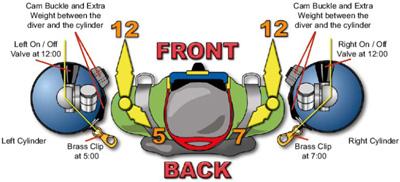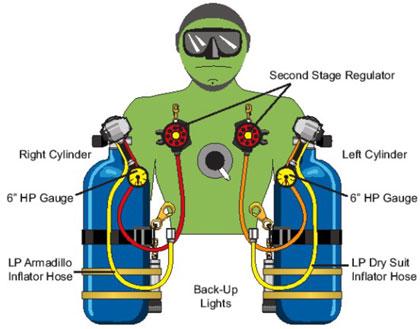I’ve heard about sidemount diving for a while now, but never really looked into it. On the surface, it seems like just another way to carry your tanks while diving. I dug a little deeper and realized there’s a bit more to it.
So what is sidemount Diving? Rather than diving with tanks on your back, you configure them so the tanks on one either side of your body.
Why sidemount vs. backmount?
1. Improved buoyancy control a more streamlined profile.
2. Better for divers with disabilities as tanks are connected when you’re in the water.
3. Easier access to tank valve/1st stage for safer air management.
Sidemount gear configuration images provided by
DivingInDepth.com:


Here is a good article by Jay Wells about using sidemount while cave diving:
Side mount diving (SM) is not just for breakfast anymore. Traditionally divers in the United States have used a SM configuration for several reasons. In Florida style caves it was developed as a means to reach lower and tighter places by SM pioneers such as Woody Jasper and Lamar Hires. It is also very popular in Great Britain, Europe, Mexico and the US as a method to reach sumps in dry caves or entrances requiring long treks horizontally or vertically. Hauling a set of doubles for long distances and lowering or raising them on vertical faces is impractical and can result in a dearth of sherpas when confronted with the task.
In general a SM diver uses two independent tanks and regulators which are connected to the body via a harness. Each tank is connected at two points. The bottom of the tank is connected to the harness near the divers hip/kidneys and the top of the tank is connected to the harness via a bungee/cord at the top of the right shoulder such that the tank valve hangs under the arm.
At that point all similarities end. In SM diving, the end justifies the means. Some sump and cave divers rely only on a dry suit/wet suit for buoyancy if it is possible or likely to crawl along the bottom. Cavers in Britain have used this method before SM was used in the US. In bigger caves where one may swim through large sections a wing is added for redundancy and trim. It is this style which seems to have become very popular in Florida by divers who are not always looking for tight spots and it is this style I would like to examine in this article.
Continue reading article here.What are your thoughts on sidemount diving? Do you have any tips, tricks or gear recommendations?Greg Davis
DiveBuddy.com